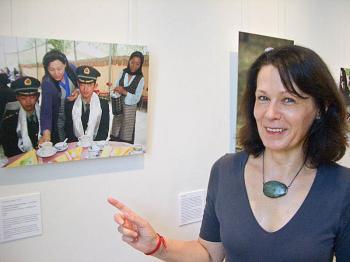One of my Chinese friends in Germany exclaimed enthusiastically, “The old imperial city of Louyang, with her peonies and poetry from the Tang Dynasty, for me is an expression of peace, riches and of harmony long ago; something that impresses me deeply.”
He spoke of the central Chinese city in positively glowing terms; Luoyang was already a highly developed metropolis during the Tang Dynasty (618-907), with more than one million residents.
Perhaps it was the old Luoyang and memories of the beauty of former Chinese culture that persuaded a group of Chinese people on May 2 of 2007 to regale the population in the streets of the city and at tourist spots by wearing traditional Han Dynasty (206 BCE to 220 AD) attire. They had come from over a dozen cities, such as Shanghai, Changzhou, Shijiazhuang, and from the older imperial city of Xi'an. They wanted to create awareness of the lost values of ancient Chinese culture.
Many legends about the establishment of Chinese culture are tied to Yellow River lore, such as deities arising from the waves to bring culture to the people. Among these beings arising from the waters is a horse with the head of a dragon, carrying a drawing on his back from which the Eight Trigrams were later developed. Legend has it that a turtle also arose from the River Luo—giving the city her name—carrying on its back an image of the future mankind.
He spoke of the central Chinese city in positively glowing terms; Luoyang was already a highly developed metropolis during the Tang Dynasty (618-907), with more than one million residents.
Perhaps it was the old Luoyang and memories of the beauty of former Chinese culture that persuaded a group of Chinese people on May 2 of 2007 to regale the population in the streets of the city and at tourist spots by wearing traditional Han Dynasty (206 BCE to 220 AD) attire. They had come from over a dozen cities, such as Shanghai, Changzhou, Shijiazhuang, and from the older imperial city of Xi'an. They wanted to create awareness of the lost values of ancient Chinese culture.
A Capital of Culture and Scientific Knowledge
Luoyang also elected 13 of her citizens to become emperors of the region, viewed as the cradle of Chinese civilization. Located south of the Yellow River, in the heart of China, the city had always played an important role; perhaps not as the seat of government, but certainly as a prominent centre for culture and scientific knowledge.
Many legends about the establishment of Chinese culture are tied to Yellow River lore, such as deities arising from the waves to bring culture to the people. Among these beings arising from the waters is a horse with the head of a dragon, carrying a drawing on his back from which the Eight Trigrams were later developed. Legend has it that a turtle also arose from the River Luo—giving the city her name—carrying on its back an image of the future mankind.



